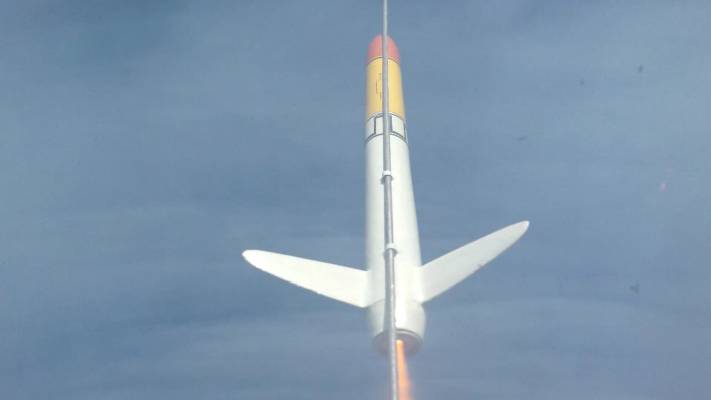The Sprint: This Astron Sprint is from the original '70s kit. It uses streamer recovery, but I changed it out for a small 8" parachute. It is designed for high-performance altitude flights, and generally requires longer-burning ejection delays for maximum height. The engine must be tape-friction-fit as this model does not have a metal motor clip. Instead it has the boattail end designed to reduce drag. This rocket was later given my "Iris" modification, which extends the body tube about 5 inches above the streamer/parachute bay, and allows for a payload with an Altimeter One to measure altitudes.
After this payload section was tragically lost when the screw-eye/balsa joint failed, I built a newer, lighter and smaller payload section. It is now 3-1/8" vs. 4-1/2", and weighs 9.8 grams. I certianly hope now I can get that extra 12 inches of altitude out of this bird and finally crack that elusive 1200 foot mark!
Originally, I replaced the flimsy crepe paper streamer with plastic one, but the plastic seems to stick to body tube because of static electricity, so I replaced it again with a small 8" parachute. With this parachute it descends at about 9 mph, soft enough for a safe grass landing. The rather small size should prevent this from drifting too much - a real problem considering the height it can attain. (The Iris altimeter payload is named after the Greek god of the rainbow. She is a messenger of the gods, linking the gods with humanity.) This rocket has flown higher than the NY Times Building in NY, the John Hancock Tower, and the Aon Center in Chicago.
| Flight Date: | 2012-03-18 |
| Rocket Name: | Sprint |
| Kit Name: | Estes - Sprint {Kit} (1249) [1970-1983] |
| Flyer's Name: | Rich DeAngelis |
| Motors: | C6-7 |
| Launch Site: | Penn Manor School Lancaster PA |
| Actual Altitude: | 1,199 Feet |
Awesome is the best description for this flight. Previously, this rocket reached 1198 feet, and today I was hoping for 1200 feet or more.
The C6-7 motor burned for 2 seconds, accelerating the Sprint to a peak of 15.2 Gs, averaging 4.4Gs for the burn. It reached a top speed of 197 mph, a record for this model. The ejection was at exactly 7 seconds at an altitude of 1192 feet while still coasting upwards. It reached it's apogee 4/10 seconds later at 1199 feet - a new record for any model of mine, but 12 inches shorter than I had hoped for!
If the delay had only been a fraction of a second too long I could have broken the 1200 mark. The small 8" chute deployed and the rocket fell at 12 mph to land within a few hundred feet of the launch pad. Overall flight time was 1 minute and 12.5 seconds.
| Stage | Motor(s) |
|---|---|
| 1 | Estes C6-7 |
 |
 |
